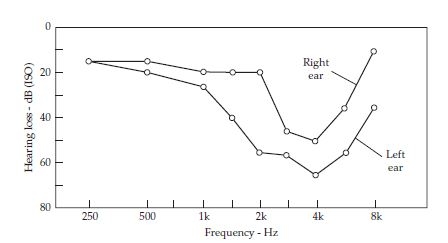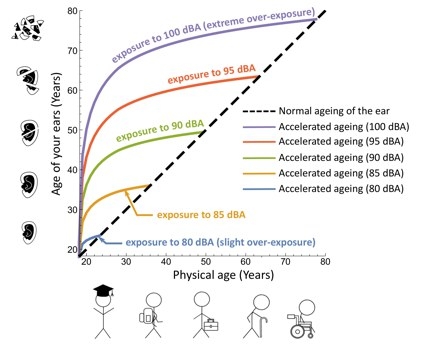From:https://blog.xuite.net/thxisf/twblog/587094520
就科學研究顯示,多數人隨著生理年紀的增長,多有聽閾提升的趨勢與現象,當然在科學研究中也有研究者發現有極少部分的人(人群)生理年紀之增長其聲閾提升的趨勢與現象並不明顯或甚微,而這些研究中所提的人(人群)非現代化城市的人(人群),幾為偏野地區、偏野部落。
大家都會有老化的一日,學習保護自己聽覺器官、面對自己聽覺器官,對音頻/音響之燒友、愛好者、相關從業者等更是重要。簡概略地分享一實際故事予看倌。
多年前,有一位年紀已長(屬老年之生理年紀)的音響愛好者,欲 DIY 喇叭給其妻舅,當其將喇叭 DIY 好後,就希望在下去聽、去測量,然而從在下第一次去聽之後,便覺有異,喇叭失真程度之嚴重,只要找個正常聽閾有常藉電聲設備聽重播聽音樂的年輕人、中壯年者,都可輕易聽出,根本已到毋須測量的地步,為何這位老先生都聽不出來????????????
當時心裏思索並評估著,甚大之懷疑、揣測老先生的聽閾應是有不小的提升,且高頻的聽力損傷應該很不小。
由於那DIY喇叭的失真之嚴重,在下每每應老生之邀前往聆聽,亦僅能每每搖頭且此般之失真根本毋須測量,在有一次的老先生的應邀測量下,在下終於帶著測量設備藉由不同的喇叭,在下不其意的開始播著20kHz 的 Sin wave 一路慢慢往下,試問老先生是否有聽到什麼聲音(老先生不知在下正在播放著Sin wave,在下耳朵早已塞上衛生紙),一試之後,確實印證了在下之揣測,聽閾有不小的提升且高頻的聽力損傷也不小,在下心中已有數,然也不好意思啟齒告知,也不好意思啟齒請其去醫院進行更精確的聽力、聽閾檢查,怕再度傷了老先生的自尊。
幾年後,悉聞,其戴上助聽器聽音樂。
MYCCT wrote:
幾年前玩耳機 怕聽力受損 所以選擇耳罩式 使用一段時間後也感覺聽力有些微下降(不習慣聽大聲 耳擴通常都轉在7-8點鐘方向) 才轉向傳統音響 奉勸耳機的愛好者 聽音樂要重質 較好的器材不用開太大聲就可表現出細節 聽力一但受損是無法回復的
供參

The audiogram of Fig. 4-20 shows serious hearing loss of a mixing engineer in a recording studio. This hearing loss, centered on 4 kHz, may be the accumulation of many years of listening to high-level sounds in the control room.
From:Handbook Acoustics, 65-66
噪聲(或娛樂聲),也常是聽力損傷的重要因素之一。
保護我們的聽覺很重要。
理性與感性 科學與藝術
https://thxisf.pixnet.net/blog
From:https://acoustics.org/4pnsa4-inciting-our-children-to-turn-their-music-down-the-age-of-your-ear-concept-jeremie-voix/
4pNSa4 – Inciting our children to turn their music down: the “Age of Your Ear” concept -Jeremie Voix
Inciting our children to turn their music down: the “Age of Your Ear” concept.
Fig. 1 : While hearing will normally worsen because of the
natural aging process (dotted black line), this ageing can be
dramatically accelerated because of over-exposure to noise (solid color
lines).

Jeremie Voix
Romain Dumoulin
École de technologie supérieure, Université du Québec, Montréal, Quebec, Canada
Popular version of paper 4pNSa4, “Inciting our children to turn their music down: the AYE concept.”
Presented Thu, Nov 08 1:45pm – 2:00pm in SALON C (VCC)
176th Meeting Acoustical Society of America and 2018
Acoustics Week in Canada (Canadian Acoustical Association) at the
Victoria Conference Centre, Victoria, BC, Canada
Problem
According to the World Health Organization (WHO), more than 1.1
billion people are currently at risk of losing their hearing due to
excessive exposure to noise. Of this, a significant proportion consists
of children, youth and young adults who are exposing themselves to
excessive levels of sound through various leisure activities (music
players, concerts, movies at the theatre, dance clubs, etc.).
Existing solutions
To address this issue, many approaches have been developed, ranging
from general awareness messages to volume limiters on personal music
players. For instance, the recent “Make listening safe” [1] initiative
from WHO aims at gathering all stakeholders, public health authorities,
and manufacturers to define and develop a consolidated approach to limit
these non-occupational sound exposures, based on dosimetry. Indeed,
significant efforts have been put into the idea of assessing directly on
a PMP (personal music player) the individual noise dose, i.e. the
product of the sound pressure level and the duration, induced during
music listening.
Need to find a better way to sensitize the users
While many technical issues are still actively discussed in some
related standards, a major concern arose with regards to the message
communicated to the end-users. End-users need to be educated on the risk
of noise induced hearing loss (NIHL) and its irreversibility, but at
the same time they also need to be made aware that NIHL is 100%
preventable pending safe listening practices are followed.
More importantly, end users have to be left with an appealing noise
dose measurement. In that regard, expressing equivalent sound pressure
level in decibels (dB) or the noise dose in percentage (%) is of little
value given the complexity of one and the abstraction of the other. But
communicating about the dangers of music playback is definitely
something very new for most of the hearing conservation specialists and
communicating with this particular group of youth is only adding to the
difficulty.
Our approach
In the quest for a meaningful message to pass to these young end
users, this article introduces a new metric, the “Age of Your Ears”
(AYE), that is an indication of the predicted extra aging caused by the
excessive noise dose each user is exposed to. To perform such
prediction, a multi-regression statistical model was developed based on
normative data found in ISO 1999 [2] standard. This way, an AYE value
can be computed for each subject, using only his age, sex and sound
exposure, to represent the possible acceleration of aging caused by
excessive music listening, as illustrated in Fig. 1.
Conclusions
In a world where personal musical players are ubiquitous, and have
also been putting hearing at risk, it is interesting to see them as
potential tool, not only to address the issues they created, but also
for raising awareness on the dangers of Noise-Induced Hearing Loss at
large.
The proposed AYE metric will be first implemented in a measurement
manikin setup that is currently under development at the Centre for
Interdisciplinary Research in Music Media and Technology, housed at the
Schulich School of Music at McGill University (CIRMMT). This setup,
further described in [3], is inspired by the “Jolene” manikin developed
though the “Dangerous Decibels” program [4]. The resulting measurement kiosk
will be complemented by a smartphone-based measurement app that will
enable musicians to assess their entire noise exposure. It is hoped that
the proposed AYE metric will be relevant and simple enough to have a
beneficial impact on everyone’s safe hearing practices.
[1] WHO – Make Listening Safe- http://www.who.int/deafness/activities/mls/en/.
[2] ISO 1999:2013 – Acoustics – Estimation of noise-induced hearing loss, 2013.
[3] Jérémie Voix, Romain Dumoulin, Julia Levesque, and Guilhem
Viallet. Inciting our children to turn their music down : the AYE
proposal and implementation. In Proceedings of Meetings on Acoustics ,
volume Paper 3007868, Victoria, BC, Canada, 2018. Acoustical Society of
America.
[4] Dangerous Decibels – JOLENE – http://dangerousdecibels.org/jolene
理性與感性 科學與藝術
https://thxisf.pixnet.net/blog
內文搜尋
X






























































































